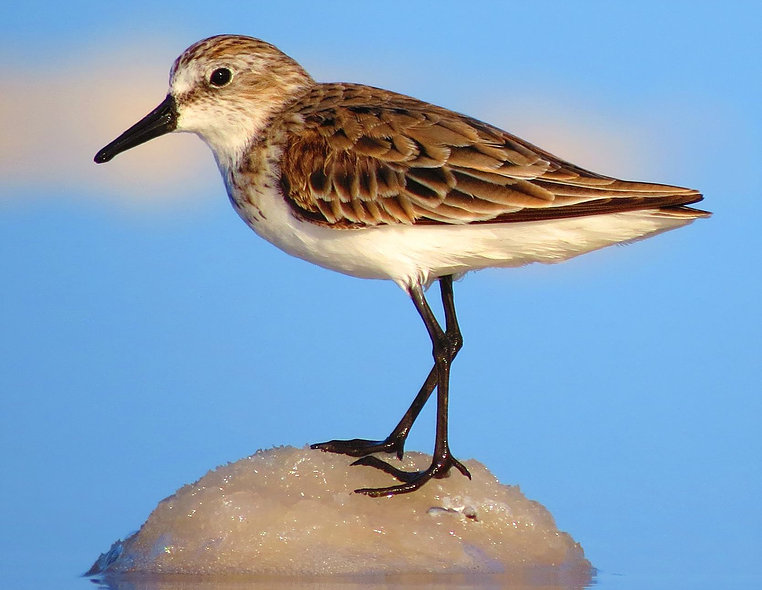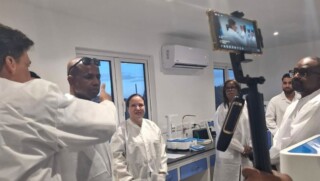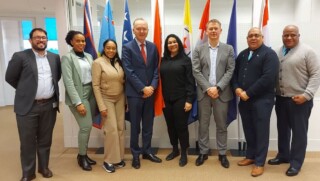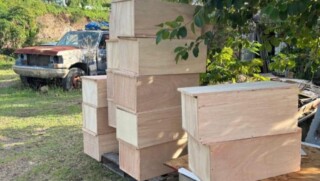Cargill Salt Ponds Bonaire First WHSRN Site in Dutch Caribbean

The semipalmated Sandpiper (Calidris pusilla) perched on salt crystal. Photo: Sipke Stapert
Kralendijk- The WHSRN Hemispheric Council has recently voted to accept the nomination of Cargill Salt Ponds Bonaire as a WHSRN Site of Regional Importance, the 103rd site to join the network.
According to WHSRN this is the first site in the Dutch Caribbean, and only the second WHSRN site in the Caribbean as a whole – joining Cabo Rojo Salt Flats in southwestern Puerto Rico. Though from a biogeographic perspective Bonaire and other Leeward Islands are part of South America, Bonaire is a “special municipality” of the Netherlands, thus adding the Netherlands as the 17th country in the network.
Cargill Salt Ponds Bonaire is a privately-owned salt production facility at the southern end of Bonaire, owned by Cargill Salt Bonaire B.V. The nomination was prepared by Daniel DeAnda Jr., the company’s Production Manager, in collaboration with Lisa Sorenson, Executive Director of BirdsCaribbean.
The site comprises 3,700 hectares, 2,700 of which are artificial wetlands – primarily solar evaporation ponds for salt extraction. Brine shrimp fill the ponds, and the dike roads between them are covered with brine flies, a crucial food source that attracts thousands of shorebirds to the harsh landscape between these mountains of salt.
Thanks to the efforts of BirdsCaribbean and the support of Cargill managers like Daniel DeAnda, intensive surveys began in 2015 to learn more about the species and numbers of birds using the site. Their surveys revealed that more than 20,000 shorebirds of 17 different species visit this large wetland complex every year, qualifying it to join the Network at the “Regional” level of importance. This large concentration of shorebirds includes at least 1% of the biogeographic population of Short-billed Dowitcher (Limnodromus griseus griseus/hendersoni) and the threatened rufa subspecies of Red Knot (Calidris canutus rufa), further supporting the designation.
The salt ponds support large numbers of several other species of migratory shorebirds, including Semipalmated Sandpiper (Calidris pusilla), Least Sandpiper (Calidris minutilla), Stilt Sandpiper (Calidris himantopus), Semipalmated Plover (Charadrius semipalmatus), and Sanderling (Calidris alba). Significant numbers of Snowy Plovers are also found regularly at the site, likely a combination of migrants (nominate Charadrius nivosus) and resident birds belonging to the Caribbean breeding subspecies (C. n. tenuirostris). The area is the only known nesting area on Bonaire for the Royal Tern (Sterna maximus), and also supports one of the most important American Flamingo (Phoenicopterus ruber ruber) nesting colonies in the Caribbean.
Surveys
Thanks to the efforts of BirdsCaribbean and the support of Cargill managers like Daniel DeAnda, intensive surveys began in 2015 to learn more about the species and numbers of birds using the site. Their surveys revealed that more than 20,000 shorebirds of 17 different species visit this large wetland complex every year, qualifying it to join the Network at the “Regional” level of importance. This large concentration of shorebirds includes at least 1% of the biogeographic population of Short-billed Dowitcher (Limnodromus griseus griseus/hendersoni) and the threatened rufa subspecies of Red Knot (Calidris canutus rufa), further supporting the designation.
The salt ponds support large numbers of several other species of migratory shorebirds, including Semipalmated Sandpiper (Calidris pusilla), Least Sandpiper (Calidris minutilla), Stilt Sandpiper (Calidris himantopus), Semipalmated Plover (Charadrius semipalmatus), and Sanderling (Calidris alba). Significant numbers of Snowy Plovers are also found regularly at the site, likely a combination of migrants (nominate Charadrius nivosus) and resident birds belonging to the Caribbean breeding subspecies (C. n. tenuirostris). The area is the only known nesting area on Bonaire for the Royal Tern (Sterna maximus), and also supports one of the most important American Flamingo (Phoenicopterus ruber ruber) nesting colonies in the Caribbean.
This new WHSRN site lies within BirdLife International’s Important Bird Area (IBA) “Pekelmeer Saltworks, Bonaire,” and also includes the 400 hectare Pekelmeer Ramsar site.
The surveys, led by BirdsCaribbean, involved international and local partners including staff and volunteers from STINAPA Bonaire, Dutch Caribbean Nature Alliance, WILDCONSCIENCE, US Fish and Wildlife Service, US Forest Service, International Programs, and Cornell Lab of Ornithology. Survey teams conducted counts at 110 points during 5 counting periods in order to gather the data needed to support this designation as a WHSRN site.
Additional pictures and background information can be seen here: https://www.whsrn.org/bonaire-site-103














